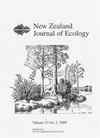The eradication of Campbell Island sheep and subsequent ecological response
IF 1.4
3区 环境科学与生态学
Q3 ECOLOGY
引用次数: 4
Abstract
: Feral sheep were eradicated from Campbell Island (Motu Ihupuku) – a National Reserve, Nature Reserve and UNESCO World Heritage Site in subantarctic New Zealand – in three distinct stages from 1970 to 1991. The sheep derived from farming attempts on the island, starting in 1895 and abandoned by 1931. The potential genetic and commercial value of the isolated sheep population meant proposed eradication plans were not wholly supported. Compromise solutions were initially implemented that required the construction of two fences, one in 1970 and one in 1984, to separate three geographic portions of the island. This separation was to facilitate staged removal of sheep and vegetation recovery in one portion of the island whilst retaining the sheep in another portion until eradication was fully committed. Sheep were largely removed by small field teams of experienced hunters using standard ground-hunting procedures in three separate operations, with follow-up operations required to remove small numbers of survivors in all three events. Approximately 7000 sheep were shot over the three operations or associated control/eradication efforts. A significant ecological response has been reported, including a recovery in range, abundance, and individual plant size for subantarctic macroforbs ( Anisotome spp., Azorella polaris , and Pleurophyllum spp.), but also for grasses ( Chionochloa antarctica and Poa spp.).坎贝尔岛羊的灭绝和随后的生态反应
:1970年至1991年,坎贝尔岛(Motu Ihupuku)是新西兰亚南极的国家保护区、自然保护区和联合国教科文组织世界遗产,分三个不同阶段根除了野羊。这些羊源于1895年开始在岛上养殖,1931年被遗弃。孤立绵羊种群的潜在遗传和商业价值意味着拟议的根除计划没有得到完全支持。最初实施的折衷解决方案需要建造两道围栏,一道在1970年,另一道在1984年,以分隔岛屿的三个地理部分。这种分离是为了促进分阶段清除岛上一部分的绵羊和植被恢复,同时将绵羊保留在另一部分,直到完全根除。在三次单独的行动中,由经验丰富的猎人组成的小型野外狩猎队使用标准的地面狩猎程序,大部分羊被移走,在所有三次行动中,都需要后续行动来移走少量幸存者。在三次行动或相关的控制/根除工作中,约有7000只绵羊被射杀。据报道,亚南极大型Forbs(Anistome spp.、Azorella polaris和Pleurophyllum spp.)以及草(Chionochloa antarctica和Poa spp.)的生态响应显著,包括范围、丰度和单株大小的恢复。
本文章由计算机程序翻译,如有差异,请以英文原文为准。
求助全文
约1分钟内获得全文
求助全文
来源期刊

New Zealand Journal of Ecology
环境科学-生态学
CiteScore
3.00
自引率
12.50%
发文量
35
审稿时长
>36 weeks
期刊介绍:
The New Zealand Journal of Ecology is a biannual peer-reviewed journal publishing ecological research relevant to New Zealand/Aotearoa and the South Pacific. It has been published since 1952 (as a 1952 issue of New Zealand Science Review and as the Proceedings of the New Zealand Ecological Society until 1977). The Journal is published by the New Zealand Ecological Society (Inc.), and is covered by Current Contents/Agriculture, Biology and Environmental Science, GEOBASE, and Geo Abstracts.
 求助内容:
求助内容: 应助结果提醒方式:
应助结果提醒方式:


